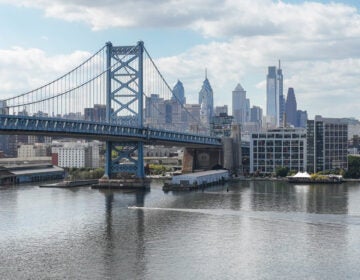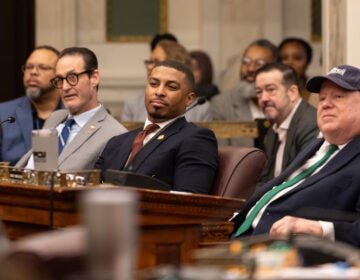A major transformation for Mt. Airy Transit Village plan
As planning continues for a possible Bottom Dollar Food supermarket at Chew Avenue and Washington Lane, a question routinely emerges: Is that part of the proposed Mt. Airy Transit Village?
The short answer is no. Although a grocery store was talked about as a desired tenant of the transit village, which was announced as a large residential-retail development alongside the Washington Lane SEPTA station, the Bottom Dollar is a separate plan.
The longer explanation is that while the Mt. Airy Transit Village still exists as a concept — an effort to bring foot traffic and dollars to the streets where East Mt. Airy meets Germantown, while encouraging public transit and uses that aren’t car-dependent — the specifics have changed dramatically from what officials announced last year, and the city and state funded through $3 million in grants.
Mt. Airy USA, the neighborhood’s busy community development corporation, let its purchase agreement on the land at Chew and Washington lapse, said Anuj Gupta, the group’s executive director. The transit village plan, discussed in community meetings at least as far back as 2007 (before Gupta came on board), had called for 200 new residential units and more than 20,000 square feet of retail in a $60 million, six-acre development.
A grocery store was mentioned as a desired retailer for the transit village, though with developer Richard L. Soloff pursuing his own plan, the Mt. Airy Transit Village now focuses solely on a possible new campus for the Wissahickon Charter School on four acres adjacent to the Awbury Arboretum.
Gupta emphasized that future of the transit village is still in its planning stages, but could include other uses like adult job training and a culinary training program in conjunction with Weaver’s Way farm. He’s wary of raising expectations again, and no official announcement has been made, though the charter school idea has been discussed in public meetings. The school’s dean of students did not return messages seeking comment for this story.
Mt. Airy Transit Village Inc., is a separate, tax-exempt entity from Mt. Airy USA, though also headed by Gupta. Its purpose, as described in tax documents, is “to develop and manage housing for low- and moderate-income residents and households in Philadelphia, and to carry out activities related to this purpose.”
But Gupta said the combined challenges of putting together a large, from-scratch residential project and attracting the right retail components proved too difficult. Gupta said Mt. Airy USA wasn’t interested in bringing fast food restaurants, check cashing shops and other businesses that might have been easy to attract but ultimately the wrong choices.
“We wanted to push the envelope to bring only development that has an impact,” Gupta said, noting that “transit-oriented development” doesn’t only mean residential-retail projects but anything that encourages active uses near transit points. The public funding is still available, he said.
Plans for a charter school
Wissahickon Charter has been located in a converted industrial space on Wissahickon Avenue since its opening a decade ago, and received district approval this year for a charter expansion that would bring its enrollment up to more than 900 students in kindergarten through eighth grades. The school also had a 624-student waiting list, according to its most recent annual report.
According to documents, the school pays nearly $600,000 a year in rent on its space, and has a lease that goes until 2026 but includes a small time frame during which the lease could be broken.
School officials didn’t return calls for comment on this story, but discussed Wissahickon Charter’s future in a recent annual report: “We conducted an exhaustive search in Northwest Philadelphia and at present have narrowed our process to one possible site which is across the street from a local arboretum and next door to a farm run by one of our partners,” the school’s report states. “If we are not able to secure funding for this site, we will stay on in our current space with some possible remodeling.”
Gupta said he thinks the combination of an environmentally-focused school adjacent to an arboretum, in one of the city’s most beloved “green” areas, could be even more transformative than a straightforward residential-retail project.
“Its central mission is connecting kids to the environment,” Gupta said, and more of the students and staff could walk to school or take public transit to the site.
Mt. Airy USA’s other projects
Meanwhile, Mt. Airy USA is continuing with other efforts, including community events and projects such as a planned new park adjacent to the Lovett Memorial Library. Also, the group continues rehabbing and re-selling residential properties.
MAUSA completed eight home rebuilds, aided by money from the city and from the U.S. Department of Housing and Urban Development’s Neighborhood Stabilization Program. Each house stayed on the market an average of five days before selling, said Brad Copeland, the group’s real estate director.
With NSP money now largely dried up, MAUSA is now attempting its first unsubsidized house resale, on a vacant house on Belfield Ave. Copeland said MAUSA isn’t shifting for good away from larger-scale residential development, but responding to the economy in a way that supports the neighborhood’s commercial growth.
“The days where you can wait for a five-year project to turn over, you can’t really do that anymore,” Copeland said. “Equally important is that incremental change, where if you can do five, six, ten properties within a specified time, you can really make a difference.”
Most recently, Mayor Nutter and other city officials came to Germantown Avenue to help MAUSA announce plans to redevelop four older, mixed-use properties in the 6500 and 6700 blocks. Three of the sites will have apartments on top, and a fourth will be totally commercial. All of the buildings will undergo substantial work before they see tenants.
The goal with those projects is to continue nudging development farther south along the avenue, Gupta said, capitalizing on streetscape and facade improvements and bolstering a burgeoning restaurant and cafe scene.
Back at Chew and Washington, Soloff is planning an 18,000 square-foot Bottom Dollar Food store and 62 parking spots on a site comprised of seven different parcels, now empty and partly fenced. He’ll meet with the community to discuss the proposal at 7 p.m. Monday, Oct. 15, at Zion Hill Church of God in Christ, before seeking zoning board approval.
NewsWorks has partnered with independent news gatherer PlanPhilly to provide regular, in-depth, timely coverage of planning, zoning and development news. Contact Amy Z. Quinn at azquinn@planphilly.com
WHYY is your source for fact-based, in-depth journalism and information. As a nonprofit organization, we rely on financial support from readers like you. Please give today.




